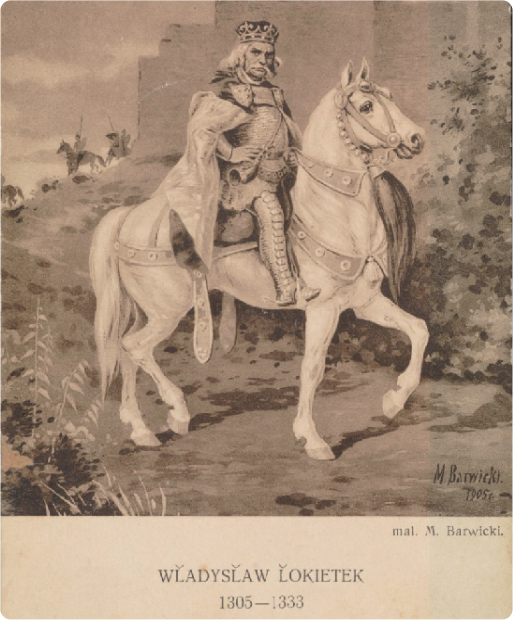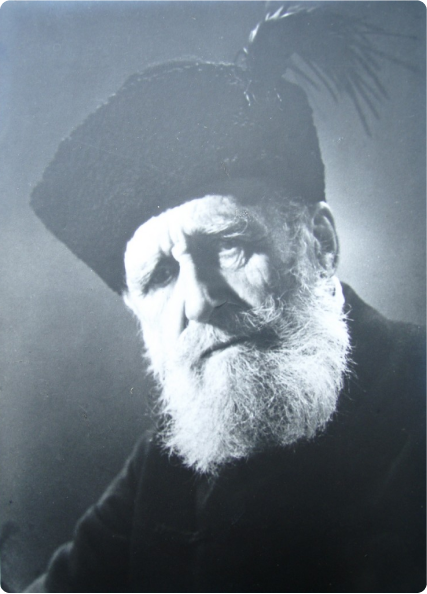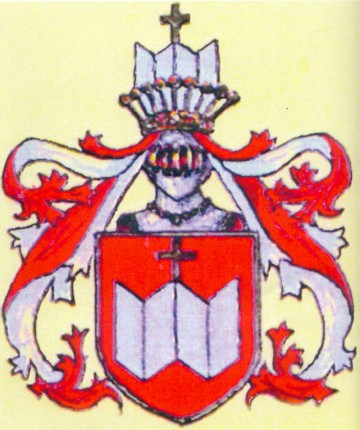The Grocholski House in the Sandomierz Voivodeship is ancient, which mentions the foundation in Grocholicach of that church… There the epitaphs agree with the foundation… There their graves are in front of the great altar, on the stones was the Syrokomla coat of arms from 1583.
Coat of Arms Legend
Everyone agrees that this coat of arms was acquired in Poland and that a knight named Syrokomla with the Abdank coat of arms was granted a cross to his native jewel for defeating and overcoming a Prussian pagan who challenged Polish youths to a duel and insulted the Christian name; therefore, as a defender of the crucified God, a cross was granted.
Kasper Niesiecki, Herbarz, VIII, 589
Description of the Coat of Arms
The Abdank should be a plain white in a red field, but on its top in the center is a golden cross. On the helmet above the crown, the same white Abdank with a cross.
Kasper Niesiecki, Herbarz, VIII, 589
SYROKOMLYA – Genus Polonicum modestique in eo viri.
SYROKOMLA – A Polish family and modest men within it.
Jan Długosz, Insignia, 27
Coat of Arms Bearers
The list of coats of arms bearers compiled by Tadeusz Gajl in the Polish Herbarz is available in this article:
Syrokomla (heraldic coat of arms)
POEMS ABOUT COAT OF ARMS AND FAMILY MEMBERS


Beginning
From hence the symbols of this coat of arms took their beginning;
King Łokietek gathered the army against the Prussians,
Still living in the pagan darkness of superstitions,
When a braggart feeling his power,
Shouts boldly, standing between two hosts,
“Let anyone who has faith in Jesus fight me in single combat,
To whom his trust is in Jesus, if he’s able;
To the God in whom I believe, let him show himself on the field,
To whom I cannot give a more beautiful sacrifice,
Here and the test of knightly virtue, here the test of faith”.
Thus blasphemed a proud German in the field
Brandishing his unsheathed rapier,
As when dogs yelp at someone’s heels.
The soldier called Syrokomla stands not,
Coat of arms Abdank, but spurs his horse,
So when the blasphemer presses to die,
Let him die; and armed with the holy cross on his chest,
Like a lion, he rushes fiercely into the fray,
Though the other from the head on his crenelated helmet
Sat to the foot in hardened iron,
And plunging the lance into the chest of his horse,
Throws him to the ground and soon it was over for the attacker,
For he loses his head first, the soul spews out first,
Before the heavy-armored German can lift himself.
Thus from the king for this knightly deed
Syrokomla took a golden cross to the Abdank.
About the Syrokomla Coat of Arms
The Syrokomla coat of arms is also written: Serokomla, Sirokomla, Sorokomla, Srokomla, Siromla, etc. According to medieval monuments, it depicts in a red field a white (silver) girdle with a similar small cross on the central girdle. The medieval crest [1] is not known. From the 16th century, the crest usually contains a repeated object from the shield, while in both the shield and the crest, the small cross is depicted as gold. It is an ancient sign, reaching back to an era earlier than the 12th century, according to A. Piekosiński at least to the era of Christianity adoption, as a proprietary sign, which became a family identifier (seals, coins), and finally placed on the shields and banners of the Knights of the family, it became a hereditary coat of arms.
Długosz (Vitae Episcoporum Poloniae) mentions under Bernard, “nobilis de domo Sirokomlya,” the Poznan bishop (+1175). The Syrokomla insignia – on ……….. buttons from the 13th century.
According to Piekosiński, Syrokomla is an older form … according to Semkowicz – it originated from …….., created as a variant of that mark by ministers (ministerial knights) from the banner of banner lords……………. Neither can be sustained. The Syrokomlas were banner lords themselves, they fought under their banner at Grunwald. The cross in Syrokomla is not an addition to the girdle ………… and is not, should not be gold. The traditions of the golden cross and its origin from …………… were first introduced into the heralds by Paprocki in “Herby Rycerstwa”, 1584.
Długosz, although in his “Arma Baronum Regni Poloniae” usually noted genetic connections between coats of arms if they existed (e.g., Topór – Starykoń; Pomian-Wieniawa, etc.), says nothing similar for Syrokomla and their connection with …….. is not mentioned: he expresses both these coats of arms quite differently:
“Habdank – tracturam albam tria cornua habentem in modum stellae in campo rubeo defert” (Cornicki Manuscript), or: “Habdank, duplex w in campo rubeo defert” (Arsenal Manuscript)
“Syrokomla – circulatulam triangularem cruce superimposita alba in campo rubeo defert” (Cornicki Manuscript).
The oldest representations of the Syrokomla emblem can be seen: on the seal of Jaśek… from Krakow from 1354 (Cistercian Archive in Mogiła), Rekosiński “Heraldry of Polish Middle Ages” pg. 156 fig 249, on the seal of Zaklika from Korzkiew, deputy of Krakow Land in 1418 (Dominican Archive in Krakow) in the so-called “marshal role” (Biblioteque de l’Arsenal, Paris No 4790 manuscript) and in the Cornicki, arsenals and other Długosz crests manuscripts, as well as on the founding board of the church in Grocholicach. Also on the seal of Jakub from Korzkiew, Bishop of Płock (Polish Archive Ak. Un. in Kr) and in the chronicle of the Constance council from 1415 by Ulrich v. Reychenthal (Augsburg 1483).
Syrokomla with a white small cross is the oldest form of the coat of arms. Only families from the Syrokomla family can claim it, as the simultaneous origin of both the family and the coat of arms; these families are: Chybicki (if they still exist; the last known about them dates to 1697, when Fr. Chybicki signed the election of Augustus II with the Warsaw land) – Grocholski – Janowscy † [2] , Kiińscy vel Kijenscy (if they exist) – Korzyniccy †, Kurdwanowski †, Pulyowie †, Świeszkowscy v. Szwayszkowscy †, Zaklikowie –
A (not complete) list of families ennobled, adopted or incorrectly using the Syrokomla coat of arms (including Lithuanian-Ruthenian).
Andronowscy variant Kijankowscy Sopockowie variant.
Baranowicz amendment Kondraccy Starosielscy ” variant.
Beynar amendment Konratowicze Stefanowicze
Bulhak amendment Konratowscy Stefanowscy
Burdzieccy Korzeniccy Staweccy
Chale amendment Koscialkowski Tracszewscy
Czechow amendment Losowicz Wahanowscy
Dziewoczkow Maslowicze Waszilewiczy amendment
Eygir amendment Minglowie Wesierscy
Gosztowt Mingelowicz Wieliczkowie variant
Gumk amendment Modzelewski Witonisc
Hale amendment Monrim Witowscz
Holibous amendment Nieszikowic Woytrowsc
Horszewic amendment Petrycz Woyniilowicze amendment
Ilga amendment Pucialtow Wyrwicz
Iwanowicz amendment Puciatsz Zagrzodze
Jalos amendment Sapals Zolaziows
Kran amendment Siennaniw Zajce and Syrokomla
Koroni amendment Siwczynci and (?) Syrokomla
Kes amendment Solshubowie Syrokomlowice
All these families, except those marked with a “variation” sign, use the Syrokomla coat of arms in its usual form, with a golden small cross. And this usual Syrokomla is often used by Lithuanian families with a plume (3 or 5 ostrich feathers) instead of repeating the “girdle.” Different shapes are sometimes barely similar to Syrokomla.
Different shapes of the usual Syrokomla were sometimes in ancient times dependent on the skills of engravers or other craftsmen, and certainly, the styles of the respective eras also influenced them. The shape of Syrokomla in the attached color drawing is taken from the foundation board of the brick church in Grocholicach with the date: “A.D. 1460.” [3]
The color of the small cross in Syrokomla – white (silver) or gold – does not influence the identity of the coat of arms. Similarly, in the same Pilawit family, some use the silver (white) Pilawy, while others the gold Pilawy.
After familiarizing oneself with everything known to date and considering that the golden small cross in its heraldic sign was used only in the 16th century, while originally the white girdle and white small cross both in the shield and crest (above the helmet) formed a whole:
“Origin… Venient (sc. arma Syrokomla) ex additione pro meritis viro militari, dicto Syrokomla de armis Abdank as noted by Bielseius fol. 277.
For when insolently the Prussian knight in Ladislaus Laconicus times (1331) provoked our knight into the theater of duel and in the course of scolding even smirched the name and glory of Christ, the noble with the arms Habdank driven by a pious affection against the unjust knight proceeded and overwhelmed the one threatening terrible with terrible hands – The king joyful gave the golden cross to the meriting noble as a reward and attached it to the arms… When I look at the present arms, I consider the cross, I consider the love of the knights, I consider the help of God and the grace of the king, and I will inscribe on them: grace of God and the king. Henry II Bourbon, King of Navarre – reports Jacobus Tipotius in symbols – had formed a symbol from pious and humble gratitude to God, the letter H adorned with roses on four sides, and added to read: the grace of God am I what I am. Nothing is truer than this? The same and Syrokomla the knight expresses in his arms saying: by the grace of God – who instructed my hands to fight for the faith of Christ, and by the grace of the king – who with a golden cross shone upon my professions, am I what I am.”
S. Okolski. Orsis Poloni. Volume III. fol. 147
The Pietniczańska line of Grocholski from Grabow uses heraldic law and returns to Syrokomla
with a white small cross, which the Family Elder hereby states ad memoriam rei –
Zdzisław Grocholski,
January 1959 in London
[1] crest : le cimier, crest, cymer?
[2] † : extinct families
[3] From Syrokomla is the same as Grocholm: Acta Vaticana, published by Ak. Um. in Krakow “Acta Cameralia” II fol 191. No. 296 under the year 1346; with the words “Ecclesia de Syrokomla”

Zdzisław Grocholski in Polish attire “Czamara” from the January Uprising, date on photo: March 1966
BASED ON NOTES BY ZOFIA FROM HR. ZAMOYSKA, TADEUSZ GROCHOLSKI’S WIFE

Delineatio
Origo.
Veninut ex additione pro meritis viro militari dicto Syrokomla de Armis Abdank ut not auit Bielscius fol. 277. Cum enim insolenter Pruscius Miles Ladislai Łoktek temporibus 1331. provocaret Militem nostrum in theatrum duelli, at que inter obiurgationes diras Christi quag; nomen et gloriam ignominia repleret, nobilis de armis Habdank pio motus affectu contra i… iquum militem processit, atque dira minantem diris supposuit maribus. Laetus Rex Auream crucem merenti nobili in praemium obtulit, et armis adfixit. Antiquitatem Armorum etiam indicat, quod Episcopus Plocensis de his armis Jacobus Anno 1391 H… …
Gratia Dei et Regis
Non immeritis ad crucem erectam in Theatro Impressarum Ioannes Ferus apposuit Christianum dogma Pignus divini Amoris. Ipse namque Salvator incitando mortalium genus instrubat dicens: “Videte est dolor sicut dolor meus”.
Summa haec gratia fuerunt Dei, summum quoque pignus crux sancta existet.
Hunc D. August lib de Catech. Rud. Anua Amorem illies qui amore tui amoris descendit interim Virginio et tibi amorem suum amori tuo Copulavit”.
Arma presentia dum inspicio, considero crucem subscribere illis iam licebit:
Gratia Dei et Regis Henricus 2 Borbonius Navarre Rex refert. Jacobius Tiportius in Symbolis denoti humilisque erga Deum gratia formanerat Symbolum literam H a quatuor partibus ornatam rosis, et addidit legendum: “Gratia Dei sum id quos sum”; “Nil hoc vero verius est”.
Idem et Syrokomla miles armis suis exprimit dicens: “Gratia Dei qui instuxit manus meas ad pugnam pro fide Christi, et gratia Regis qui aura crucefactum collustramit meum, sum id quod sum”.
Expressit gladio et affectu quod instruebat D. August. Constans et perfectus debet esse amor noster, ut si nesse fuerit, amore illius moriamur, qui amore nostri placide ae benigne mori dignatus est Peacuit in proposito Illustris et Reverendiss. Scipio Gonzaga Presb. Card. et Partriarcha in Hierusalem, qui ad Crucem in Manu inprimere docuerat: “Potius mori quam fidem fallere” …it Typotius: “Qui enim Christum confessus, fuerit coram hominibus confitebitur eum Patrem qui in Coelis est”.
Justinus Imperator secreti cuiusdam gratia in nulle is suis imprimi decrenit literam M, quam Crucibus et stellis a lateribus adornanit qui subs… sit:” Cuis p… et pigeat” C. lul Caes de Nun. Rom: Si co… iec placebit docuit quo vir fit magnus, et quo Minimus: “Amore et Pudore” enim Dei et Patriae, pudorem… … Consilium non habet; set totus scopus sic amantis et Chrisitus et Deus: et eo sit magnis at que illi splendores, honores, lumina stellae bicebunt. Minimus vero in Regno et Familia sit, non amore, non pudore, unde Apocalips.
Qui sordet sordescant adhuc: “Pugnavit sic D. Martinus Amore, pugnavit Themistocles pudore. … m Mitridatem humiliter natum triumphantem conspexit. Refloreat igitur in posteritate Pareneis Syrokomlae Meritum et militia accedero praemium, Gratia Dei et Regis non seguiter incipiet. Igitur itote per annos seculaque et priscae titulos praecedite famae.
Family Line of Syrokomla
Syrokomla knight brave, who first received such arms in 1331 as we said in the origin who because good gifts were made founded the village Syrokomla in the Cracow Palat…, Grocholskijae, Grocholice, in the Sandomierz Palatinate.
Builders of the Church and founders are recorded there. Jacob Grocholski Canon Crac.: made it for me in 1460. “Others accepting division of goods perunt note their Family from Grabów from Radom district… were namely Nicolai and Stanislai German brothers goods Grocholice, Grabów and Paciorkowa Wola. Hence possesses that about relinquishing goods under them the various naming. Nicholas Grocholski man of grains, had daughters 2. Albert and Andrea, this one contracted marriage with Margaret Wielgorska had sons Valentin and Matthew, who later became religious in the Order of Preachers was Master of S. Theology and Provincial, daughters namely Szartowska and Makowska. Andrea indeed brave soldier in Podolia, after diverse military actions with Elizabeth Wydżanka from Rzyczyce sister of the subjudge Leopol. he held the bond of sacramental matrimony and left sons Stanislaus, who made vows to God in the Order of Preachers John.
Strong man, Ezeziel, who consecrated days to the heavenly Lord’s business and is Theology Reader among Preachers and in the Province of Russia their Provincial in A. 1644 Andrea and Christopher soldiers, whose sister Lucas Guzelphi. Stanislaus, Nicholas’ brother, with Barbara from Podhaice Wolska left Luke, Andrea, George at John and with another marriage Job George in Rokosz killed by the infantry of horses trampled while defending the Royal side Job from Sulimirska left progeny. Thomas soldier.
I made on the basis of handwritten notes made by my great-grandmother Zofia from count Zamoyskich Tadeusza Grocholska.
